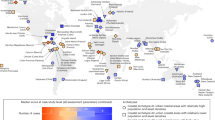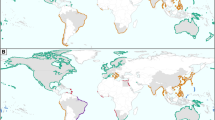Abstract
Local governments are not adapting to sea-level rise because it is difficult to build consensus on the need for change and the best way to implement it. In theory, adaptation pathways can resolve this impasse. Adaptation pathways are a sequence of linked strategies that are triggered by a change in environmental conditions, and in which initial decisions can have low regrets and preserve options for future generations. We report on a project that sought to empirically test the relevance and feasibility of a local pathway for adapting to sea-level rise. We find that triggers of change that have social impacts are salient to local people, and developing a local adaptation pathway helps build consensus among diverse constituencies. Our results show that adaptation pathways are feasible at the local scale, offering a low-risk, low-cost way to begin the long process of adaptation to sea-level rise.
This is a preview of subscription content, access via your institution
Access options
Subscribe to this journal
Receive 12 print issues and online access
$209.00 per year
only $17.42 per issue
Buy this article
- Purchase on Springer Link
- Instant access to full article PDF
Prices may be subject to local taxes which are calculated during checkout


Similar content being viewed by others
References
Stafford-Smith, M. et al. Rethinking adaptation for a 4 °C world’. Phil. Trans. R. Soc. A 369, 196–216 (2011).
Hurlimann, A. et al. Urban planning and sustainable adaptation to sea-level rise. Landscape Urban Plan. 126, 84–93 (2014).
O’Riordan, T., Nicholson-Cole, S. & Milligan, J. Designing sustainable coastal futures. Twenty-first Century Soc. 3, 145–157 (2008).
Moser, S. C., Williams, S. J. & Boesch, D. F. Wicked challenges at Land’s End: Managing coastal vulnerability under climate change. Annu. Rev. Environ. Res. 37, 51–78 (2012).
Berke, P. & Lyles, W. Public risks and the challenges of climate change adaptation: A proposed framework for planning in the age of uncertainty. Cityscape 15, 181–208 (2013).
Cheong, S-M. et al. Coastal adaptation with ecological engineering. Nature Clim. Change 3, 787–791 (2013).
Parson, E. A. & Karwat, D. Sequential climate change policy. WIRES Clim. Change 2, 744–756 (2011).
Abunnasr, Y., Hamin, E. & Brabec, E. Windows of opportunity: Addressing climate uncertainty through adaptation plan implementation. J. Environ. Plan. Manage. http://dx.doi.org/10.1080/09640568.2013.849233 (2013).
Hallegatte, S. Strategies to adapt to an uncertain climate. Glob. Environ. Change 19, 240–247 (2009).
Levin, K. et al. Overcoming the tragedy of super wicked problems: Constraining our future selves to ameliorate global climate change. Policy Sci. 45, 123–152 (2012).
Wilby, R. & Dessai, S. Robust adaptation to climate change. Weather 56, 180–185 (2010).
Wilson, C. & McDaniels, T. Structured decision-making to link climate change and sustainable development. Clim. Policy 7, 353–370 (2007).
Downing, T. Views from the frontiers in climate adaptation economics. WIRES Clim. Change 3, 161–170 (2012).
Haasnoot, M. et al. Dynamic adaptive policy pathways: A method for crafting robust decisions for a deeply uncertain world. Glob. Environ. Change 23, 485–498 (2013).
Kwadijk, J. C. J. et al. Using adaptation tipping points to prepare for climate change and sea level rise: A case study in the Netherlands. WIRES Clim. Change 1, 729–740 (2010).
Wise, R. et al. Reconceptualising adaptation to climate change as part of pathways of change and responses. Glob. Environ. Change http://dx.doi.org/10.1016/j.gloenvcha.2013.12.002 (in the press).
Ranger, N., Reeder, T. & Lowe, J. Addressing ‘deep’ uncertainty over long-term climate in major infrastructure projects: Four innovations of the Thames Estuary 2100 Project. EURO J. Decis. Process. 1, 233–262 (2013).
Walker, W. E., Haasnoot, M. & Kwakkel, J. H. Adapt or perish: A review of planning approaches for adaptation under deep uncertainty. Sustainability 5, 955–979 (2013).
Waters, E., Barnett, J. & Puleston, A. Contrasting perspectives on barriers to adaptation in Australian climate change policy. Climatic Change 124, 691–702 (2014).
Measham, T. G. et al. Adapting to climate change through local municipal planning: Barriers and challenges. Mitig. Adapt. Strateg. Glob. Change 16, 889–909 (2011).
Flugman, E., Mozumder, P. & Randhir, T. Facilitating adaptation to global climate change: Perspectives from experts and decision makers serving the Florida Keys. Climatic Change 112, 1015–1035 (2011).
Moser, S. C. in Successful Adaptation to Climate Change: Linking Science and Policy in a Rapidly Changing World (eds Moser, S. C. & Boykoff, M. T.) 289–305 (Routledge, 2013).
Burch, S. et al. in Successful Adaptation to Climate Change: Linking Science and Policy in a Rapidly Changing World (eds Moser, S. C. & Boykoff, M. T.) 270–286 (Routledge, 2013).
Fincher, R. et al. Time stories: Making sense of futures in anticipation of sea-level rise. Geoforum 56, 201–210 (2014).
Brace, C. & Geoghegan, H. Human geographies of climate change: Landscape, temporality, and lay knowledges. Prog. Hum. Geogr. 35, 284–302 (2011).
Baker, I. et al. Local government response to the impacts of climate change: An evaluation of local climate adaptation plans. Landscape Urban Plan. 107, 127–136 (2012).
Bedsworth, L. & Hanak, E. Adaptation to climate change: A review of challenges and tradeoffs in six areas. J. Am. Plan. Assoc. 76, 477–495 (2010).
Macintosh, A. Coastal climate hazards and urban planning: How planning responses can lead to maladaptation. Mitig. Adapt. Strateg. Glob. Change 18, 1035–1055 (2012).
McSweeney, K. & Coomes, O. Climate-related disaster opens a window of opportunity for rural poor in northeastern Honduras. Proc. Natl Acad. Sci. USA 108, 5203–5208 (2011).
Spence, A. et al. Perceptions of climate change and willingness to act sustainably influenced by flood experiences. Nature Clim. Change 1, 46–49 (2011).
Hall, J. et al. Proportionate adaptation. Nature Clim. Change 2, 833–834 (2012).
Graham, S. et al. Local values for fairer adaptation to sea-level rise: A typology of residents and their lived values in Lakes Entrance, Australia. Glob. Environ. Change 29, 41–52 (2014).
Barnett, J. et al. Equitable Local Outcomes in Adaptation to Sea-Level Rise. (Univ. Melbourne, 2014); http://msd.unimelb.edu.au/equitable-outcomes-adaptation-sea-level-rise
McInnes, K., Macadam, I. & Hubbert, G. Climate change in Eastern Victoria – Stage 3 Report: The effect of climate change on extreme sea levels in Corner Inlet and the Gippsland Lakes (CSIRO, 2006).
Sjerp, E. & Charteris, A. Discussion Paper – Sea Level Change and Costal Subsidence: Implications for Geomorphological Aspects and Associated Physical and Natural Assets of the Gippsland Coast (Gippsland Coastal Board, 2007).
Grayson, R. et al. Gippsland Lakes Flood Level Monitoring Project: Final Report (Centre for Environmental Applied Hydrology, Univ. Melbourne, 2004).
Acknowledgements
Thanks to our partners in the East Gippsland Shire Council and The Victorian Government for their support of and participation in this research, and to the residents of Lakes Entrance who participated in this study. This research was funded by the Australian Research Council project LP100100586.
Author information
Authors and Affiliations
Contributions
All authors participated in the design of the study and in writing the paper. J.B., S.G., C.M. and E.W. conducted the workshop with local decision-makers. J.B., R.F., S.G. and C.M. conducted the focus groups, and analysed the data.
Corresponding author
Ethics declarations
Competing interests
The authors declare no competing financial interests.
Rights and permissions
About this article
Cite this article
Barnett, J., Graham, S., Mortreux, C. et al. A local coastal adaptation pathway. Nature Clim Change 4, 1103–1108 (2014). https://doi.org/10.1038/nclimate2383
Received:
Accepted:
Published:
Issue Date:
DOI: https://doi.org/10.1038/nclimate2383
This article is cited by
-
The timing of decreasing coastal flood protection due to sea-level rise
Nature Climate Change (2023)
-
Navigating the continuum between adaptation and maladaptation
Nature Climate Change (2023)
-
Tracking Pathways to Recovery from Climate Shocks and Resilience Enhancement
Environmental Management (2023)
-
Internal relocation as a relevant and feasible adaptation strategy in Rangiroa Atoll, French Polynesia
Scientific Reports (2022)
-
Marae-opoly: supporting localised Māori climate adaptation decisions with serious games in Aotearoa New Zealand
Sustainability Science (2022)



